Identification of Structural Constituents in Advanced Multiphase High-Strength Steels Using Electron Back-Scattered Diffraction
Abstract
1. Introduction
2. Materials and Methods
2.1. Materials
2.2. Description of Experimental Methods
3. Results and Discussion
3.1. SEM Observations
3.2. Kikuchi Diffraction Bands
3.3. EBSD Analysis of the Multiphase Steel Belonging to the 1st Generation of AHSS
3.4. EBSD Analysis of the Multiphase Steel Belonging to the 3rd Generation of AHSS
4. Conclusions
- Ferrite in a low-Mn steel and tempered martensite in a medium-Mn steel have the highest IQ, CI and KAM values due to their lowest dislocation density. The areas containing martensite formed as a result of SIMT or the transformation of unstable austenite upon cooling show the opposite tendency due to its high dislocation density and significant lattice distortion. Bainite and RA have intermediate CI, IQ and KAM values and particular values are dependent on their morphology, size and dislocation density;
- RA with the FCC crystallographic lattice is distinguished within the microstructure using phase distribution maps. The location of RA is easier to identify by analyzing K-S and N-W orientation relationships with misorientation angles close to 45°;
- Changes in the microstructure caused by the plastic deformation applied during tensile straining are reflected in an increase in dislocation density and corresponding increased fractions of martensite formed due to the SIMT. Some areas of low CI index and IQ parameter values, as well as an increased fraction of regions showing high KAM values are observed after tensile straining.
Author Contributions
Funding
Data Availability Statement
Acknowledgments
Conflicts of Interest
References
- Czerwinski, F. Current Trends in Automotive Lightweighting Strategies and Materials. Materials 2021, 14, 6631. [Google Scholar] [CrossRef] [PubMed]
- Raabe, D.; Sun, B.; Kwiatkowski Da Silva, A.; Gault, B.; Yen, H.W.; Sedighiani, K.; Sukumar, P.H.; Souza Filho, I.R.; Katnagallu, S.; Jagle, E.; et al. Current Challenges and Opportunities in Microstructure-related Properties of Advanced High-strength Steels. Metall. Mater. Trans. A 2020, 51, 5517–5586. [Google Scholar] [CrossRef]
- Kučerová, L.; Opatová, K.; Káňa, J.; Jirková, H. High versatility of niobium alloyed AHSS. Arch. Metall. Mater. 2017, 62, 1485–1491. [Google Scholar] [CrossRef]
- Vercruysse, F.; Celada-Casero, C.; Linke, B.M.; Verleysen, P.; Petrov, R.H. Temperature Dependence of the Static and Dynamic Behaviour in a Quenching and Partitioning Processed Low-Si Steel. Metals 2020, 10, 509. [Google Scholar] [CrossRef]
- Wiewiorowska, S.; Muskalski, Z.; Ciepiela, W. Intensification of the Transition of Retained Austenite to Martensite Effected by Changing the Stress State in Trip Steel Wires. Arch. Metall. Mater. 2015, 60, 2730–2731. [Google Scholar] [CrossRef][Green Version]
- Kowalska, J.; Ryś, J.; Cios, G.; Bednarczyk, W. The effect of reduced temperatures on microstructure development in tensile tested high-manganese steel. Mater. Sci. Eng. A 2019, 767, 138406. [Google Scholar] [CrossRef]
- Jabłonska, M.B.; Jasiak, K.; Kowalczyk, K.; Bednarczyk, I.; Skwarski, S.; Tkocz, M.; Gronostajski, Z. Deformation Behaviour of High-Manganese Steel with Addition of Niobium Under Quasi-static Tensile Loading. Mater. Sci. Pol. 2022, 40, 1–11. [Google Scholar] [CrossRef]
- Śmiglewicz, A.; Jabłońska, M.; Moćko, W.; Kowalczyk, K.; Hadasik, E. Properties and structure of X30MnAlSi26-4-3 high strength steel subjected to dynamic compression processes. Arch. Metall. Mater. 2017, 62, 2255–2260. [Google Scholar] [CrossRef]
- Kaar, S.; Krizan, D.; Schneider, R.; Sommitsch, C. Impact of Si and Al on Microstructural Evolution and Mechanical Properties of Lean Medium Manganese Quenching and Partitioning Steels. Steel Res. Int. 2020, 91, 2000181. [Google Scholar] [CrossRef]
- Leták, R.; Jirková, H.; Kucerová, L.; Jenícek, S.; Volák, J. Effect of Forming and Heat Treatment Parameters on the Mechanical Properties of Medium Manganese Steel with 5% Mn. Materials 2023, 16, 4340. [Google Scholar] [CrossRef]
- Gramlich, A.; Middleton, A.; Schmidt, R.; Krupp, U. On the Influence of Vanadium on Air-Hardening Medium Manganese Steels for Sustainable Forging Products. Steel Res. Int. 2021, 92, 2000592. [Google Scholar] [CrossRef]
- Kučerová, L.; Jandova, A.; Rubešová, K. Microstructure Analysis and Mechanical Properties of Low Alloyed Steel with Retained Austenite Obtained by Heat Treatment. Manuf. Technol. 2019, 19, 243–247. [Google Scholar] [CrossRef]
- Hidalgo, J.; Celada-Casero, C.; Santofimia, M.J. Fracture Mechanisms and Microstructure in a Medium Mn Quenching and Partitioning Steel Exhibiting Macrosegregation. Mater. Sci. Eng. A 2019, 754, 766–777. [Google Scholar] [CrossRef]
- Hojo, T.; Koyama, M.; Kumai, B.; Shibayama, T.; Shiro, A.; Shobu, T.; Saitoh, H.; Ajito, S.; Akiyama, E. Comparative Study of Stress and Strain Partitioning Behaviors in Medium Manganese and Transformation-Induced Plasticity-Aided Bainitic Ferrite Steels. Scr. Mater. 2022, 210, 114463. [Google Scholar] [CrossRef]
- Filippone, R.; Root, J.; Jacques, P.; Yue, S. The Influence of Martensite on Line Broadening in Neutron Diffraction Spectra of a DP steel. ISIJ Int. 2002, 42, 304–309. [Google Scholar] [CrossRef]
- Baghdadchi, A.; Hosseini, V.A.; Karlsson, L. Identification and Quantification of Martensite in Ferritic-Austenitic Stainless Steels and Welds. J. Mater. Res. 2021, 15, 3610–3621. [Google Scholar] [CrossRef]
- Gnäupel-Herolda, T.; Creuziger, A. Diffraction Study of the Retained Austenite Content in TRIP Steels. Mater. Sci. Eng. A 2011, 528, 3594–3600. [Google Scholar] [CrossRef]
- Mythili, R.; Kirana, R.; Singh, L.H.; Govindaraj, R.; Sinha, A.K.; Singh, M.N.; Saroja, S.; Vijayalakshmi, M.; Deb, S.K. Identification of Retained Austenite in 9Cr-1.4W-0.06Ta-0.12C Reduced Activation Ferritic Martensitic Steel. Symmetry 2022, 14, 196. [Google Scholar] [CrossRef]
- Das, P.P.; Plana-Ruiz, S.; Galanis, A.S.; Stewart, A.; Karavasili, F.; Nicolopoulos, S.; Putz, H.; Margiolaki, I.; Calamiotou, M.; Iezzi, G. Structure Determination Feasibility of Three-Dimensional Electron Diffraction in Case of Limited Data. Symmetry 2022, 14, 2355. [Google Scholar] [CrossRef]
- Wang, X.; Xu, Y.; Gao, Y.; Wang, Y.; Misra, R.D.K. Enhancing Strength-ductility Combination in a Novel Cu-Ni Bearing Q&P Steel by Tailoring the Characteristics of Fresh Martensite. J. Mater. Res. Technol. 2023, 24, 9015–9029. [Google Scholar] [CrossRef]
- Singh, V.; Mondal, C.; Sarkar, R.; Roy, S.; Omprakash, C.M.; Ghosal, P. Characterization of Microstructure of Crept Nb and Ta-Rich γ-TiAl Alloys by Automated Crystal Orientation Mapping and Electron Back Scatter Diffraction. Symmetry 2022, 14, 399. [Google Scholar] [CrossRef]
- Petrov, R.; Kestens, L.; Wasilkowska, A.; Houbaert, T. Microstructure and Texture of a Lightly Deformed TRIP-assisted Steel Characterized by Means of the EBSD Technique. Mater. Sci. Eng. A 2008, 447, 285–297. [Google Scholar] [CrossRef]
- Zaefferer, S.; Romano, F.; Friedel, F. EBSD as a Tool to Identify and Quantify Bainite and Ferrite in Low-alloyed Al-TRIP Steels. J. Microsc. 2008, 230, 499–508. [Google Scholar] [CrossRef] [PubMed]
- Ryde, L. Application of EBSD to Analysis of Microstructures in Commercial Steels. Mater. Sci. Technol. 2006, 22, 1297–1306. [Google Scholar] [CrossRef]
- Radwański, K. Structural Characterization of Low-carbon Multiphase Steels Merging Advanced Research Methods with Light Optical Microscopy. Arch. Civ. Mech. Eng. 2016, 16, 282–293. [Google Scholar] [CrossRef]
- De Knijf, D.; Petrov, R.; Föjer, C.; Kestens, L.A.I. Effect of Fresh Martensite on the Stability of Retained Austenite in Quenching and Partitioning Steel. Mater. Sci. Eng. A 2014, 615, 105–115. [Google Scholar] [CrossRef]
- Kozłowska, A.; Kokot, G.; Matus, K.; Grajcar, A. Monitoring the Phase Evolution and Fracture Behavior of Advanced Multiphase QP Steel Using EBSD Technique and Digital Image Correlation. Theor. Appl. Fract. Mech. 2024, 113, 104520. [Google Scholar] [CrossRef]
- Radwański, K. Application of FEG-SEM and EBSD Methods for the Analysis of the Restoration Processes Occurring During Continuous Annealing of Dual-Phase Steel Strips. Steel Res. Int. 2015, 85, 9999. [Google Scholar] [CrossRef]
- Zaefferer, S.; Ohlert, J.; Bleck, W. A Study of Microstructure, Transformation Mechanisms and Correlation Between Microstructure and Mechanical Properties of a Low Alloyed TRIP Steel. Acta Mater. 2004, 52, 2765–2778. [Google Scholar] [CrossRef]
- Chen, J.; Lv, M.; Tang, S.; Liu, Z.; Wang, G. Coupled Toughening of a Low Carbon Medium Manganese Heavy Steel Plate Investigated by Electron Baccattered Diffraction (EBSD). Mater. Lett. 2016, 175, 203–206. [Google Scholar] [CrossRef]
- Grajcar, A.; Zalecki, W.; Kuziak, R. Designing of Cooling Conditions for Si-Al Micro Alloyed TRIP Steel on the Basis of DCCT Diagrams. J. Achiev. Mater. Manuf. Eng. 2011, 45, 115–124. [Google Scholar]
- Kozłowska, A.; Skowronek, A.; Grzegorczyk, B.; Grajcar, A. Thermodynamic Approach for Designing Processing Routes of 4Mn Quenching and Partitioning Steel. J. Therm. Anal. Calorim. 2024. [Google Scholar] [CrossRef]
- Woźniak, D.; Zak, A. Influence of vertical straightener roller shape on residual stress level in railway rails. Arch. Metall. Mater. 2024, 69, 245–255. [Google Scholar] [CrossRef]
- de Assumpção Pereira-da-Silva, M.; Ferri, F.A. Scanning Electron Microscopy. In Nanocharacterization Techniques; William Andrew Publishing: Norwich, NY, USA, 2017; pp. 1–35. [Google Scholar] [CrossRef]
- De Vincentis, N.S.; Field, D.P. Factors Affecting Confidence Index in EBSD Analysis. Ultramicroscopy 2021, 225, 113269. [Google Scholar] [CrossRef]
- Field, D.P. Recent Advances in the Application of Orientation Imaging. Ultramicroscopy 1997, 67, 1–9. [Google Scholar] [CrossRef]
- Allain-Bonasso, N.; Wagner, F.; Berbenni, S.; Field, D.P. A Study of the Heterogeneity of Plastic Deformation in IF Steel by EBSD. Mater. Sci. Eng. A 2012, 548, 56–63. [Google Scholar] [CrossRef]
- Podder, A.S.; Bhadeshia, H.K.D.H. Thermal Stability of Austenite Retained in Bainitic Steels. Mater. Sci. Eng. A 2010, 527, 2121–2128. [Google Scholar] [CrossRef]
- Zajac, S.; Schwinn, V.; Tacke, K.H. Characterisation and Quantification of Complex Bainitic Microstructure in High and Ultra-high Strength Linepipe Steels. Mater. Sci. Forum. 2005, 500–501, 387–394. [Google Scholar] [CrossRef]
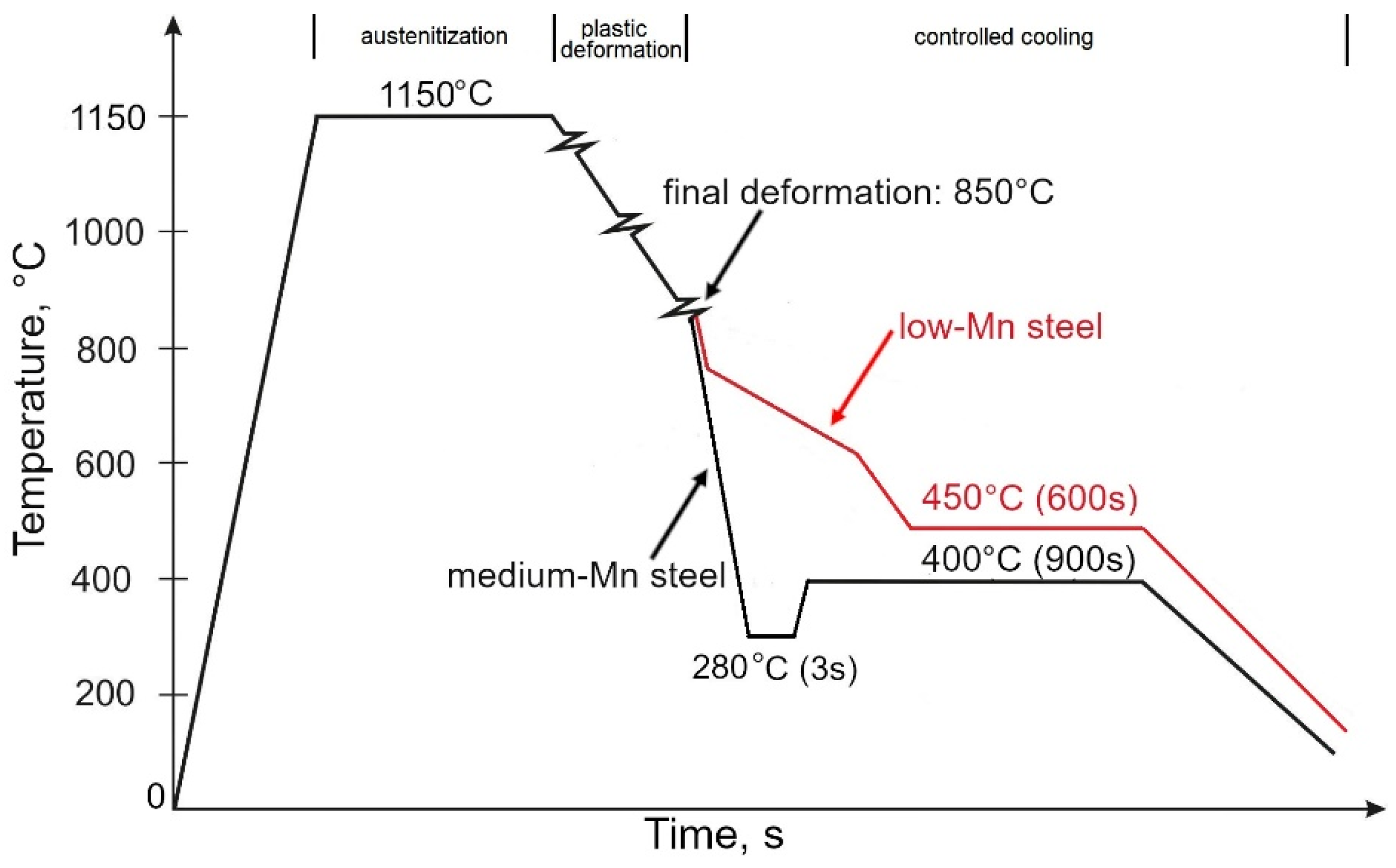
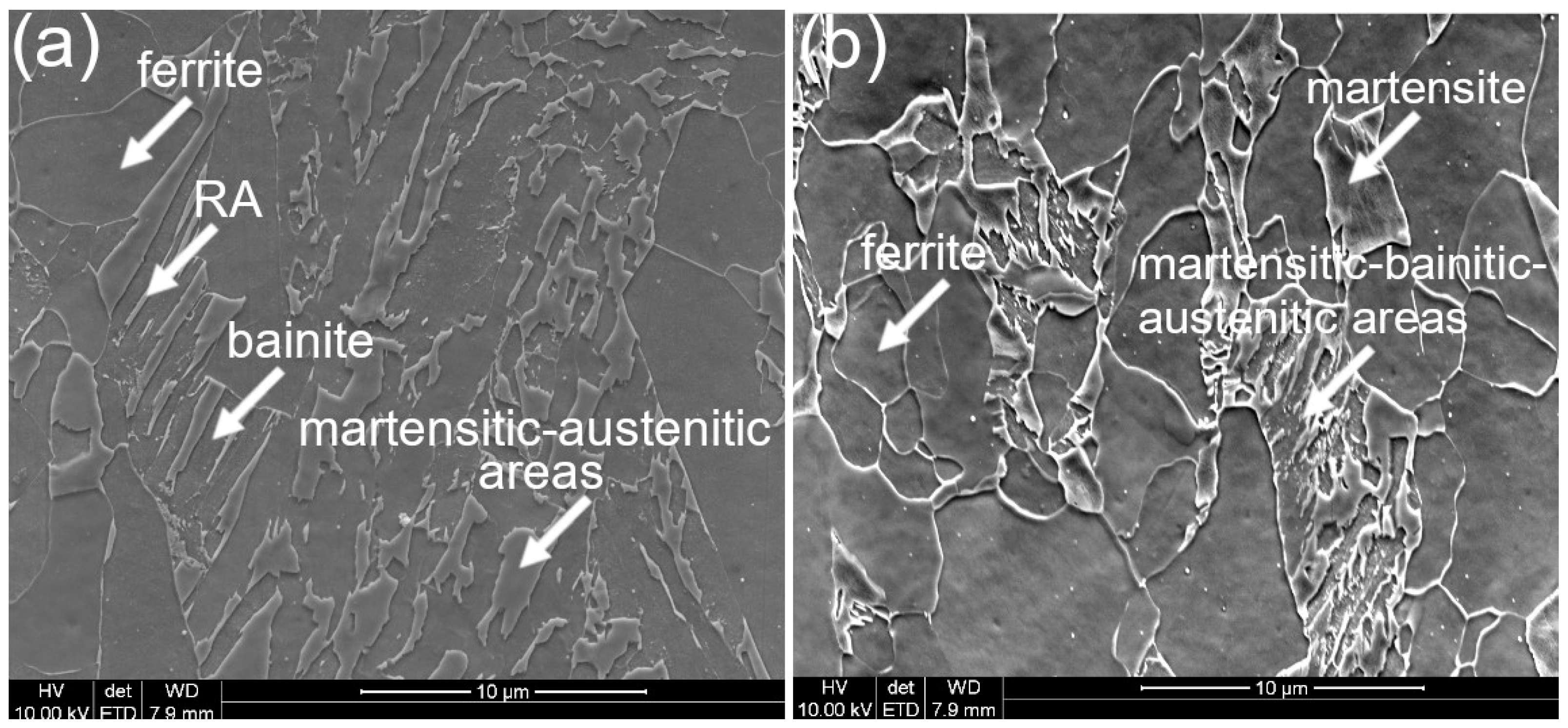

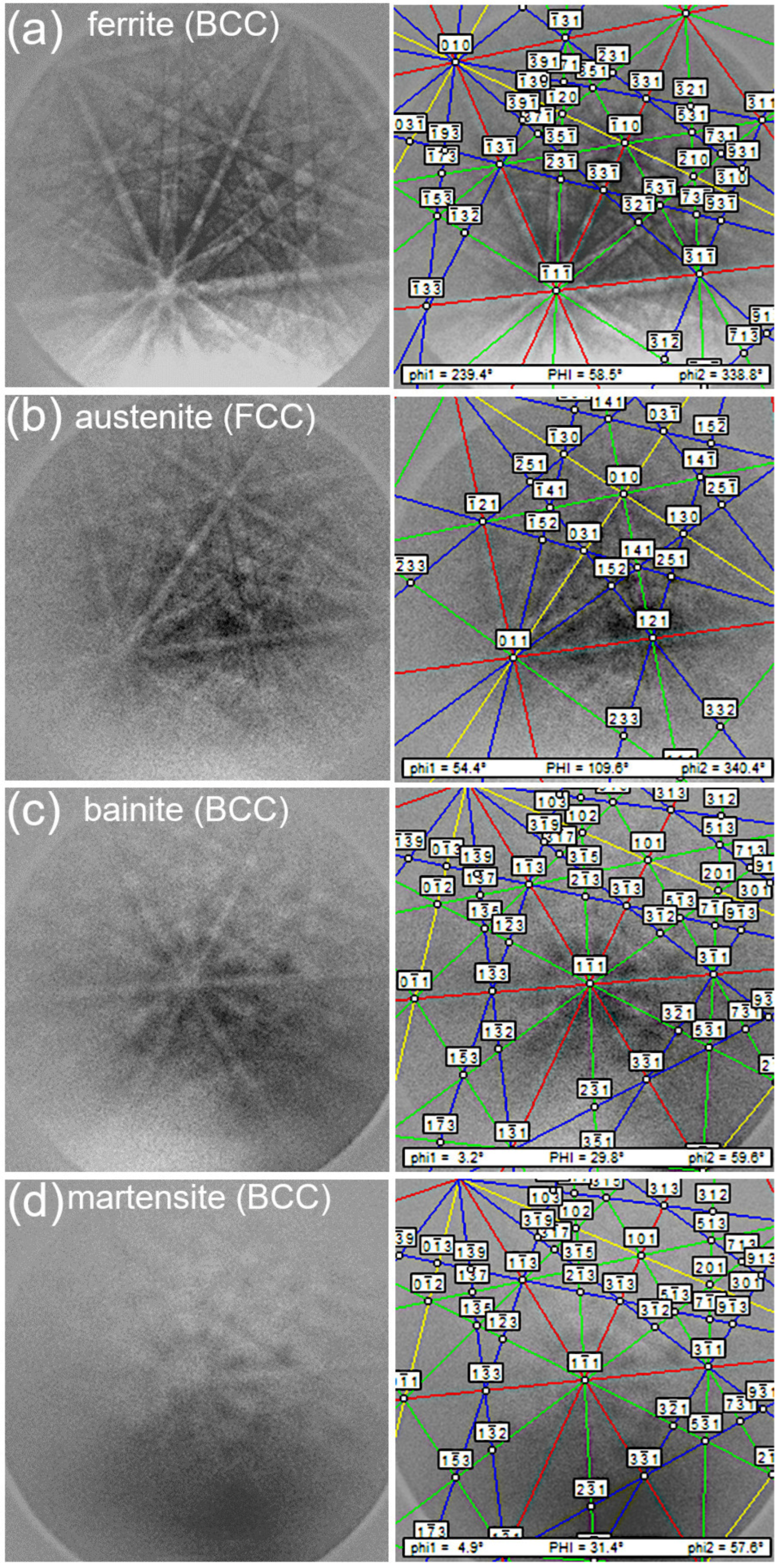
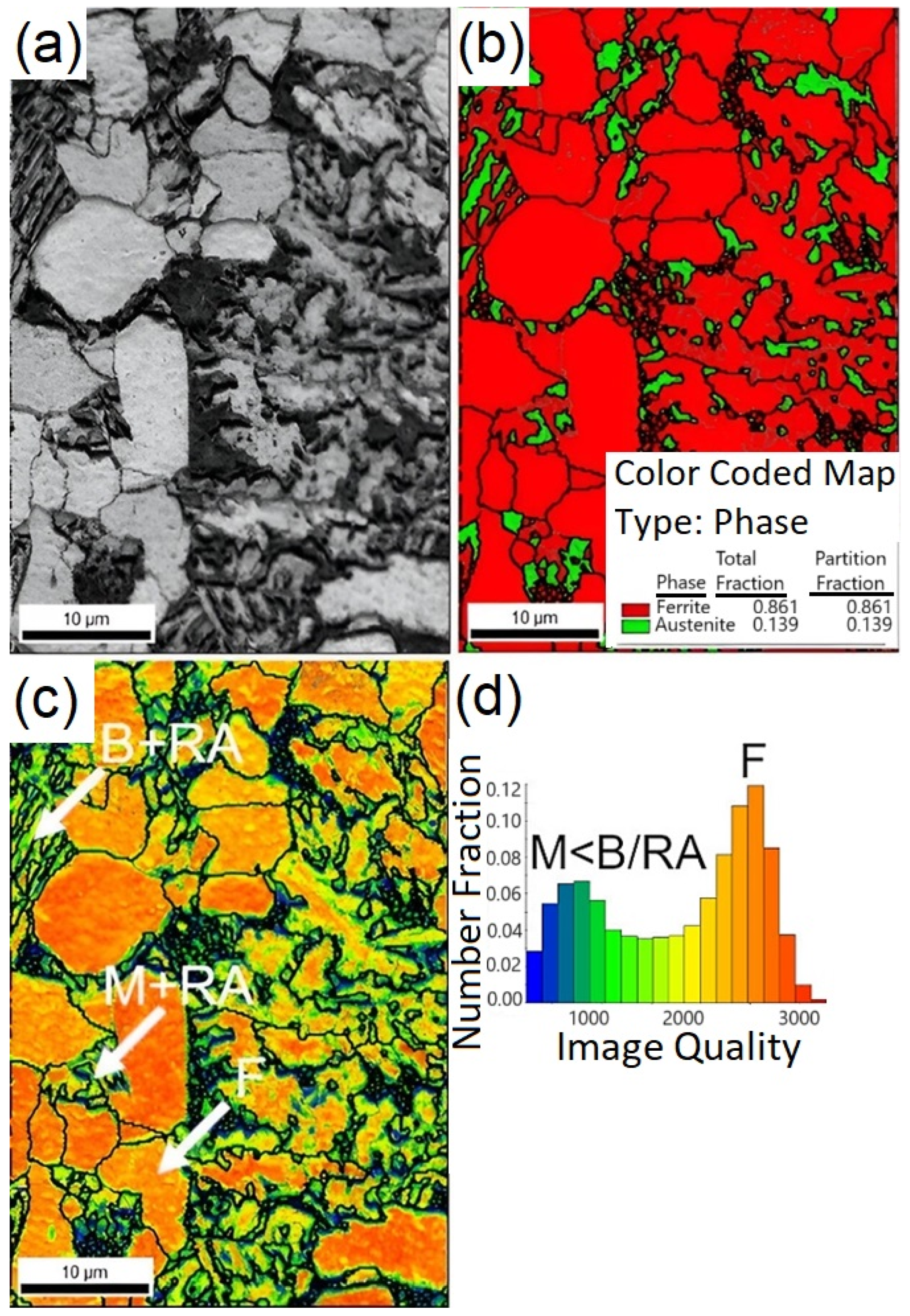
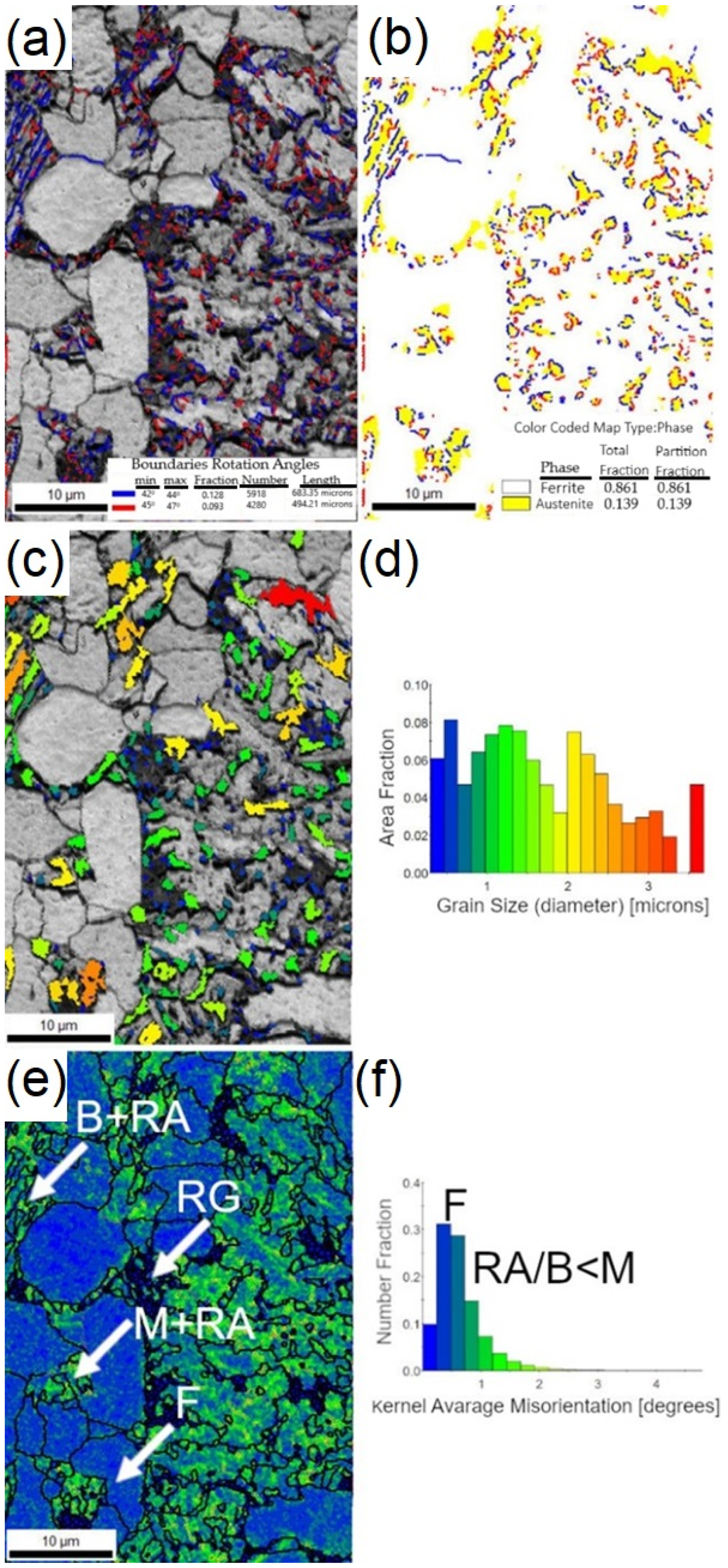
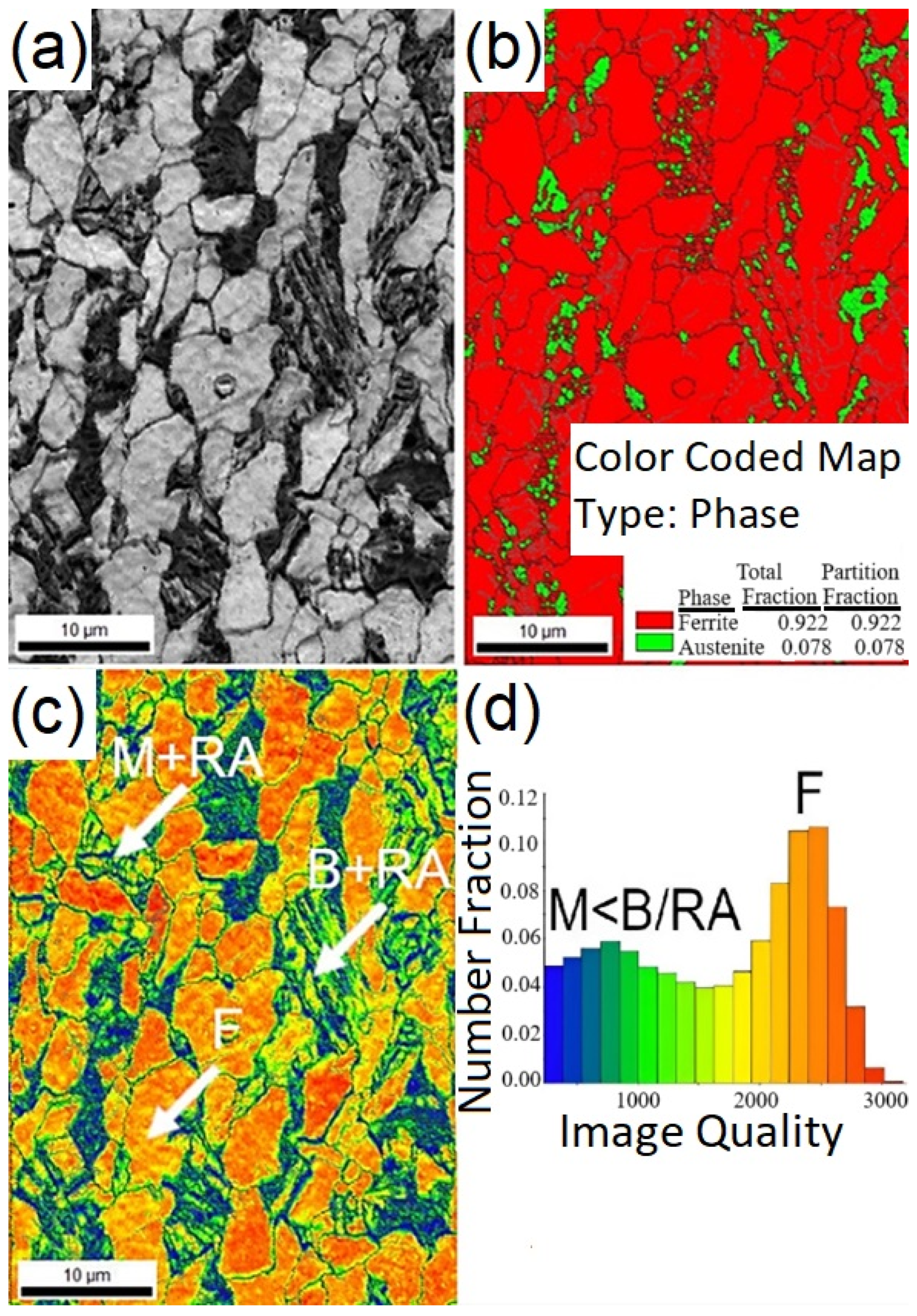
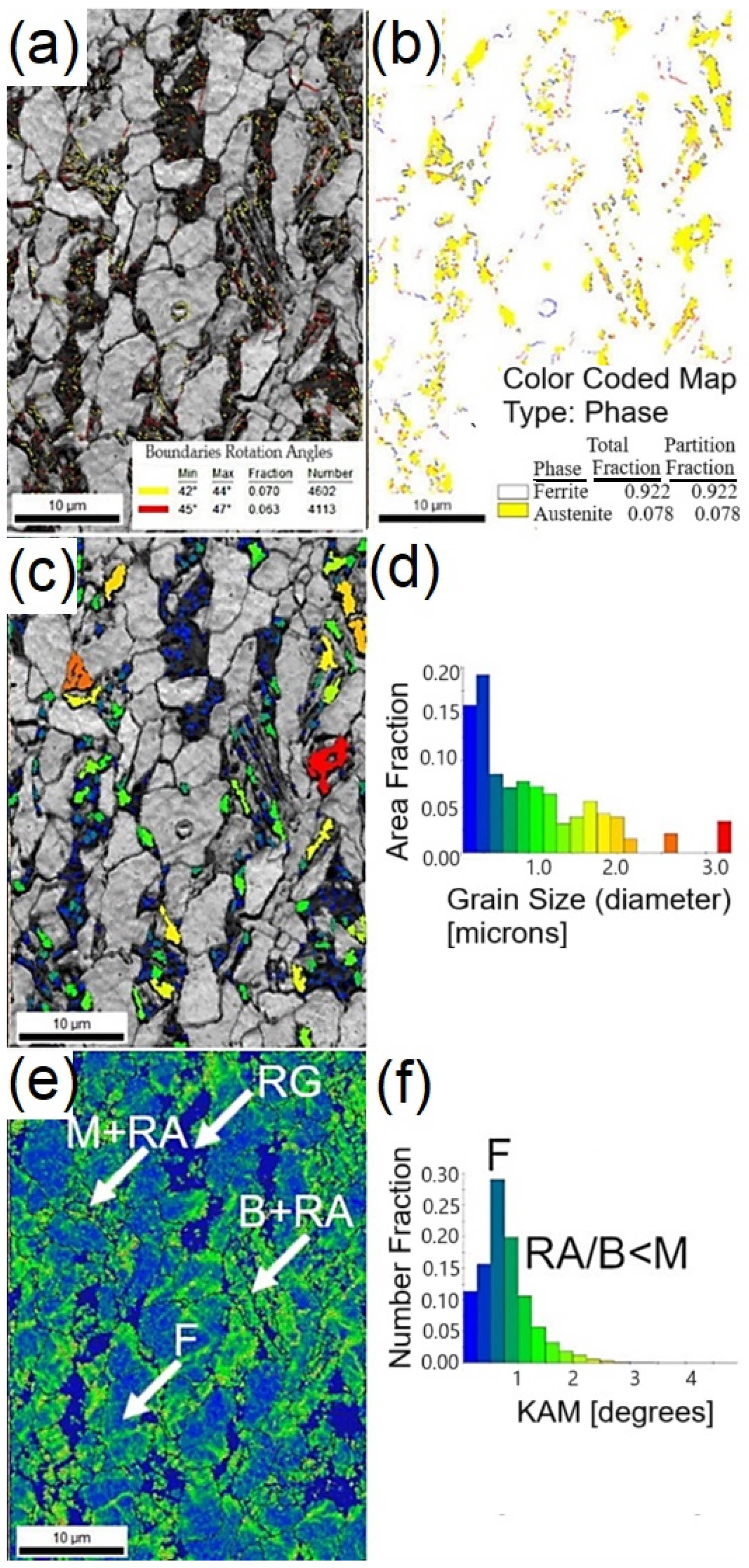

| Steel Designation | C | Mn | Al | Si | Nb | Ti | Fe |
|---|---|---|---|---|---|---|---|
| Low-Mn | 0.24 | 1.55 | 0.40 | 0.87 | 0.034 | 0.023 | Bal. |
| Medium-Mn | 0.17 | 4.20 | 0.98 | 0.87 | 0.054 | - | Bal. |
| Type of Orientation Relatnioship | Parallel Planes | Parallel Direction | Misorientation Angle, ° |
|---|---|---|---|
| Kurdjumov-Sachs | (111)γ//(011)α | [101]γ//[111]α | 42–44 |
| Nishiyama-Wassermann | (111)γ//(011)α | [112]γ//[011]α | 45–47 |
| Microstructural Constituent | CI | IQ | KAM | Characteristic Misorientation Angles, ° |
|---|---|---|---|---|
| Ferrite (F) | F > RA, B, M | F > RA, B, M | F < RA, B, M | - |
| Retained austenite (RA) | F > RA/B > M | F > RA/B > M | F < RA/B < M | K-S (42–44) N-W (45–47) |
| Bainite (B) | M > B/RA > F | F > B/RA > M | F < B/RA < M | 50–55 |
| Martensite (M) | M < B, RA, F | M < B, RA, F | M > B, RA, F | 55–60 |
Disclaimer/Publisher’s Note: The statements, opinions and data contained in all publications are solely those of the individual author(s) and contributor(s) and not of MDPI and/or the editor(s). MDPI and/or the editor(s) disclaim responsibility for any injury to people or property resulting from any ideas, methods, instructions or products referred to in the content. |
© 2024 by the authors. Licensee MDPI, Basel, Switzerland. This article is an open access article distributed under the terms and conditions of the Creative Commons Attribution (CC BY) license (https://creativecommons.org/licenses/by/4.0/).
Share and Cite
Kozłowska, A.; Radwański, K.; Grajcar, A. Identification of Structural Constituents in Advanced Multiphase High-Strength Steels Using Electron Back-Scattered Diffraction. Symmetry 2024, 16, 1630. https://doi.org/10.3390/sym16121630
Kozłowska A, Radwański K, Grajcar A. Identification of Structural Constituents in Advanced Multiphase High-Strength Steels Using Electron Back-Scattered Diffraction. Symmetry. 2024; 16(12):1630. https://doi.org/10.3390/sym16121630
Chicago/Turabian StyleKozłowska, Aleksandra, Krzysztof Radwański, and Adam Grajcar. 2024. "Identification of Structural Constituents in Advanced Multiphase High-Strength Steels Using Electron Back-Scattered Diffraction" Symmetry 16, no. 12: 1630. https://doi.org/10.3390/sym16121630
APA StyleKozłowska, A., Radwański, K., & Grajcar, A. (2024). Identification of Structural Constituents in Advanced Multiphase High-Strength Steels Using Electron Back-Scattered Diffraction. Symmetry, 16(12), 1630. https://doi.org/10.3390/sym16121630







